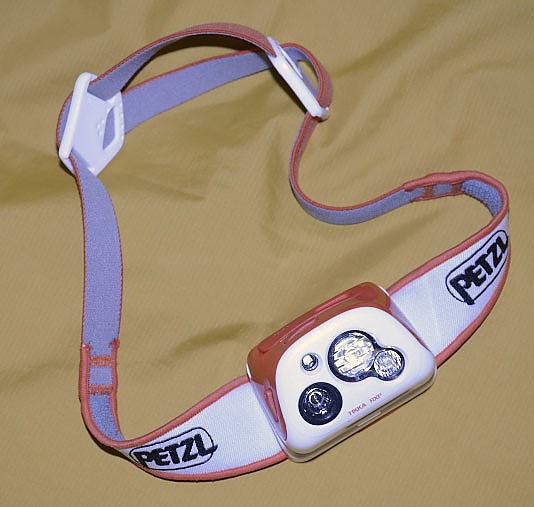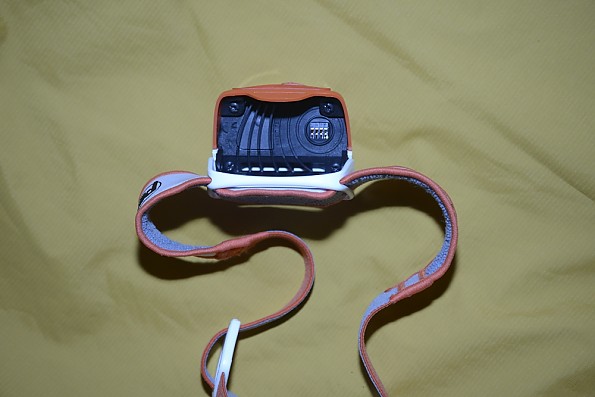Petzl Tikka RXP
The Tikka RXP has been discontinued. If you're looking for something new, check out the best headlamps for 2025.
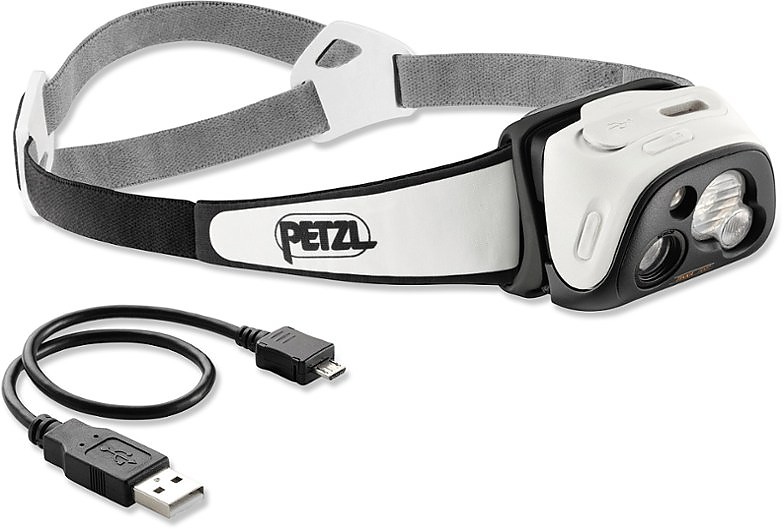
The Petzl Tikka RXP is a very high tech headlamp featuring a wide range of brightness levels (215 - 7 lumens) and automatic adjustment of brightness according to ambient conditions. It is similar in operation and features to the Petzl NAO, but in a much smaller package that is much easier to use.
It is intended for use in a wide range of outdoor activities, including mountaineering, orienteering, trail running, via ferrata, rock and ice climbing, and many more. The included lithium-ion battery is rechargeable and located inside the headlamp module. Petzl has long been known for their high performance headlamps.
In short, I would recommend that any climber, orienteer, backpacker, or others engaged in outdoor activities involving night-time activity (or spelunkers) give serious consideration to the RXP.
Pros
- Bright focused LED, paired with lower brightness diffuse LED for reading
- Programmable light level profiles to match the activity, from trail running to pre-dawn approaches to bivouacking (pre-programmed and customizable).
- On brightest setting, excellent for route-finding for pre-dawn approaches, running orienteering courses, or those late night descents back to the trailhead
- On lower settings, excellent for reading when tent-bound or bivouacking
- Automatically variable light level (Reactive lighting), works well for mapreading while hiking or orienteering
Cons
- Reactive Mode should not be used while bicycling (Petzl recommendation)
- Computer needed to select or modify lighting profiles
- Battery life is too short for long night approaches, trail runs, orienteering, or for multiday expeditions, unless you stay at low light levels or can frequently recharge
- Cannot use batteries other than the included rechargeable lithium battery (Petzl website indicates a battery holder for AAA batteries will be available)

Background: As discussed in my previous headlamp reviews (Pelican 2750, BD Icon Polar , Petzl NAO), I have used everything from candle lanterns, kerosene lanterns, and carbide headlamps through various battery-powered miner’s headlamps to the current light-weight LED headlamps to make approaches to climbs, ski tour and orienteer at night, go spelunking, and commuting by bicycle over the years. The scrap pile has also included a variety of handheld lights.
I have roundly cursed many in this catalog of lamps in the dark of the night (or deep in a cave) when they failed me, some due to failing batteries or running low on carbide, and some due to failures of the lamps themselves by burned-out bulbs (with no spare available), broken wiring, broken contact springs, corrosion from leaking batteries, or just plain too dim.
Most of my Petzl lamps have done very well (in spite of the deficiencies of battery technology), including the Myo5 and Zoom. Over the past decade, headlamp technology has made huge leaps forward in dependability and lighter weight (thanks to the brightness and efficiency of LEDs and improvements in batteries).
For many outdoor activities, whether on the trail or in camp, having a light source that is dependable is vital. I heavily use lights for approaches, returning to the trailhead or camp after a long day, and studying the map, or reading a book while holed up in the tent. There are several requirements I have for a lamp:
- It has to have a long enough battery life to provide light during the full duration of the activity at hand, including any delays.
- It has to provide an appropriate level of light during the various stages of the trip.
- It has to be light enough weight to be comfortable to wear, or for a tent light, have a convenient way to hang it.
- For map reading, the color of the light has to render all the map colors clearly (red or yellowish lights tend to mask yellow or red markings to almost invisible or in some cases producing a color shift that masks details).
- It has to be durable enough to survive the rough handling that inevitably happens during an expedition.
- It has to be easily found in the pack (none of those tiny black LED lights that hide inside a black pack!)
- For my winter, high altitude, and polar trips, it has to perform at low temperatures, as well as wet conditions.
- The final question is “Do I really need a headlamp this bright, this automated, and this expensive?”
Details: I had briefly looked at the RXP at the Outdoor Retailer Show. Having tested its cousin, the Petzl NAO and its “reactive lighting” for the Trailspace Gear Review Corps, I was intrigued by the smaller, lighter size of the RXP. So, when Trailspace’s Chief of Gear Reviews, Seth, offered the RXP to me for testing, I decided to check it out.
The unit arrived in recyclable packaging with basic data on the outside and the usual Petzl overly brief, cartoony instruction sheet inside with information in what must be 4 point type in 12 languages, of which I can read 5 (with the help of a dictionary) plus maybe a sixth if I count Italian, which is close to Spanish. I always have fun with multi-language instructions, since they help me keep up my skills for travelling (plus dealing with the increasingly large number of languages spoken here in the SFBay Area – I help at the polls during election time, where we in California have ballots in 4 or 5 languages).
The white and coral color of the headlamp makes it easy to find in your pack
The instruction sheet is available on line as well (in 19 languages, of which I can still read only 5), as is a huge amount of useful material. Petzl is excellent in providing detailed information on their website on how to use their gear properly, and in this case, detailed information on how the performance parameters are determined. I resorted to the online version, since I can enlarge the type on the screen of my computer to where my increasingly presbyopic eyes can read it. At the same time, I downloaded the Petzl OS software to get the latest version. Like all the most recent high-powered headlamps, the list price is pretty stiff ($90), though far less than the NAO.
The cartoons in the instructions do help understanding of the various functions of the ON/OFF/MODE and the Technology buttons. There are several precautions, the first of which is highlighted in yellow and presented in English and French (sooo, what do the readers of the other 17 languages do?) This is LED risk group 2 – IEC 62471 – “Do not stare at operating lamp. May be harmful to the eyes” At 215 lumens maximum power, staring at the lamp is likely to induce temporary blindness, although it is less bright than the NAO’s 355 lumens. A more complete version of the warning does appear in each language section, with particular emphasis on avoiding shining the light into another person’s eyes, especially children who can suffer retinal damage.
Each language section also has a disclaimer that Petzl is not responsible for any “consequences, direct, indirect, or accidental, or any other type of damage befalling or resulting from the use of its products.” In other words, BE CAREFUL with high power lights.

The RXP (left) compared to the NAO (right)
A second caution in the instruction sheet is a repeat of the one on the NAO instructions about RFI (radio frequency interference). As with many electronic devices, a small amount of RFI leaks and can interfere with radio receivers such as avalanche beacons, even though the device meets RF standards such as 2004/108/CE.
I performed several tests by setting the RXP at maximum brightness and bringing it close to my ham radio handheld and several of my avalanche beacons in search mode. The RFI was noticeable with the HT when I got the RXP within about 4 inches of the antenna. With the avy beacons, a signal was detected within 4 to 5 inches (slightly farther with my newest triaxial digital beacon). Moving the beacon away from the headlamp (or vice versa) resolves the problem.
In addition, few avalanche searches are conducted under conditions requiring use of the headlamp. This is, however, something to keep in mind when using any electronically controlled headlamp around electronic devices.
Step 1 after removing the coral and white lamp from the packaging was to plug the battery into one of my USB wall adapters to insure a full charge. The color of the lamp body and headstrap makes it easier to find in your pack. While the lithium ion battery was charging, the next step was to download and install the current version of the Petzl OS software on my computer. Unlike the old version of the OS which I downloaded for the NAO, the only supplied profile for the RXP was the MultiSport which includes both Reactive and Constant technologies. You can either load canned profiles from the website or customize a profile for your particular usage.
For the NAO, 7 profiles were available, including MultiSport, Mountaineering, Trail Running, Orienteering, Bivouacking, Caving, and Around Home, with both Reactive and Constant modes for each. A small LED on the right side of the headlamp shows blinking green while charging. As it discharges, it changes color from green to orange (66% down to 33%), to red (in reserve 33% to 0%). After 300 discharge/recharge cycles, the battery capacity is reduced to about 70% of its initial capacity.
The RXP with the case open and rechargeable lithium-ion battery removed
The rechargeable battery, indicating the charging socket.
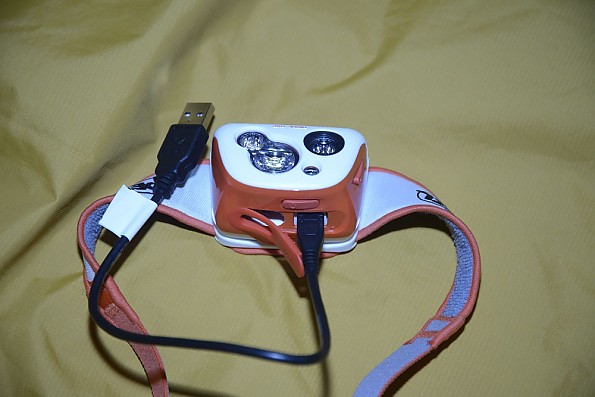
The socket is accessible while inside the case as well, shown here with the supplied USB charging/programming cable
The headlamp is turned on by pressing and holding the ON/OFF/MODE button (top of the headlamp) for 2 seconds. If you press the button for more than 2 seconds (say, accidentally in a pocket or pack), the headlamp turns off and remains that way until you have released the button (or removed it from your pocket or pack) and then do only the 2 second hold. You turn it off by pressing and holding the ON/OFF/MODE button for 2 seconds, until the red light flashes.
I have had dead batteries on flashlights, GPS receivers, MP3 players, and ham radios more than once due to the switch being accidentally depressed in the pack or a pocket (many devices have poor switch designs that allow accidental depression, as more than one friend has found out with PLBs and PLB-type devices). While the RXP does not have a “lock” switch position per se, if the power button is depressed for more than a few seconds, the headlamp turns off, thus reducing the likelihood of draining the battery unknowingly.
The lighting technology setting is selected with the headlamp on by pressing the technology button (right side of the headlamp) to step through the 3 choices of Reactive, Constant, or Red lighting. As the name implies, in “Constant” lighting setting, the brightness of the light remains at the same level (except for battery depletion) throughout the battery life. When turning on the light, you choose which of 3 levels of brightness you will use (45, 100, or 150 lumens on a fully charged battery, for nominal battery lifetimes of 10, 5, and 2h30min respectively).
The “Reactive lighting” setting activates the use of the sensor to adjust the headlamp’s brightness to suit the ambient conditions. While in Reactive lighting, you select the mode by pressing the ON/OFF/MODE button to step through the Max Autonomy (80 lumens max, 10 h life), Standard (160 lumens max, 5 h life), and Max Power (215 lumens max, 2h30min life) settings. Minimum brightness in Reactive lighting is 7 lumens.
In the Reactive setting, the sensor will detect the ambient light and automatically reduce the light output of the two LEDs (the spot LED with the clear lens for the narrowest, brightest beam and the flood LED with the spreader lens for the broadest and least bright beam). If you are hiking on a dark night with little reflectivity from your surroundings (dark rock on a talus slope or a dense forest, for example), the energy will be directed to the spot LED. On the other hand, if you need to glance at your map, the light dims immediately to prevent affecting your night vision. It will also dim on a snow slope or glacier, or if you are facing a bright light source, such as the full moon, an oncoming car’s headlights, or an approaching hiker with a bright headlamp.
The instruction sheet for the NAO had a warning, which also appears in the RXP literature – “Do not use the lamp in Reactive Lighting mode when road biking: the lamp can dim significantly when exposed to automobile headlights.” During my testing of the NAO, and again while testing the RXP, I established that indeed this is the case, as well as changing brightness when you are going along a trail where there is a mix of dark trail or trees and very light surfaces, or even an on-coming hiker with a headlamp. If you are looking around, thus moving the direction the sensor is pointing, this continual changing of the light level sometimes is a bit disconcerting, though I became accustomed to the changes and could anticipate when they would happen. With an oncoming car headlight, the road ahead of the bicyclist could virtually disappear suddenly.
With both the NAO and the RXP, I even found on my Full Moon hike that turning a bend in the trail to face the full moon, the Reactive Mode goes to a very low light level to save battery life. Your alternative is to use the headlamp in the Constant mode when bicycling or hiking busy trails. Since it is easy to switch between Reactive and Constant lighting modes (plus the Red mode) with the “technology” button, it may be desirable to do this when there are approaching hikers.
During my many hikes while testing headlamps on the crowded Mission Peak trail, I have become accustomed to turning my head to direct the beam away from other hikers. On backcountry trails, this is not likely to be a problem, although simple courtesy and awareness of how bright these headlamps are dictates keeping the beam directed away from one’s fellow partners.
In the Reactive lighting, there is “boost” function, which allows you to temporarily (20 seconds) “boost” the light output to the maximum value.
Details of testing: One of the first formal tests I performed after playing with the buttons and taking a few walks around the block after sundown was to measure the battery life. As noted above, Petzl gives a battery life of 2h30m for the Constant lighting setting at maximum brightness (150 lumens). I set the RXP aimed toward a white wall at a distance of 1 meter, as the only light source in a closed-off dark room. As explained below, “lumens” is the measure of total light output of the lamp over the full 4 π steradians. The energy density within the light pattern at a given point is measured in “lux”.
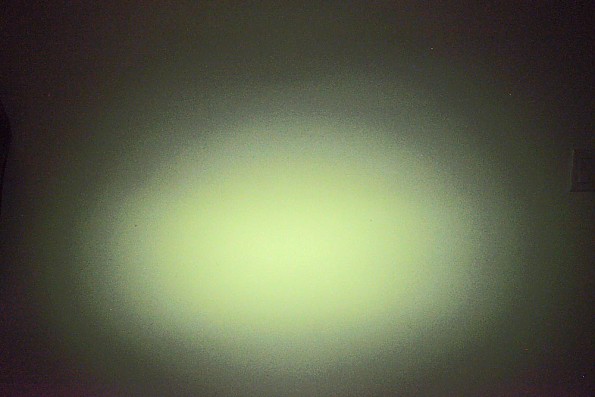
Wide beam (slightly enhanced to match visual appearance)
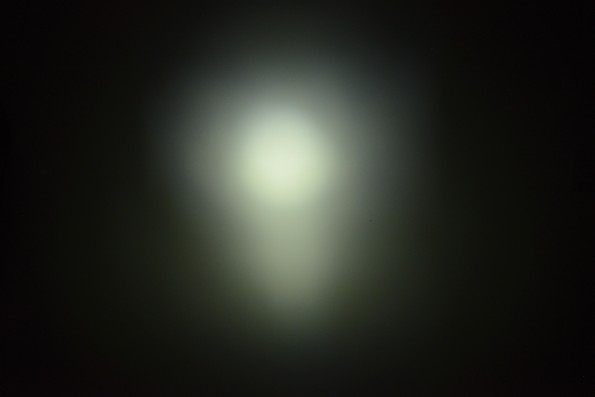
Mid beam (Constant Lighting, as photographed, no enhancement)
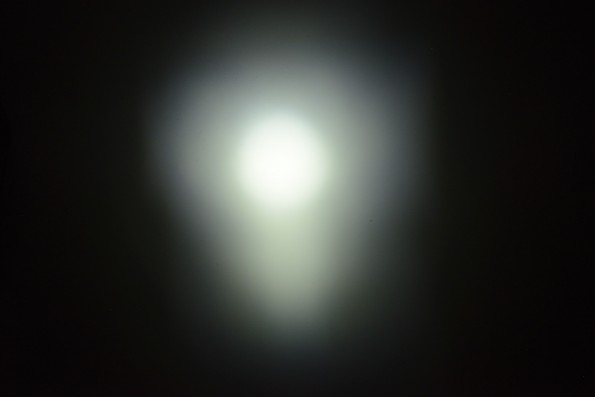
Brightest beam (Constant Lighting, as photographed, no enhancement)
I photographed the light patterns and measured the beam center brightness of all 3 levels of the Constant lighting setting. The light patterns are shown in the above images. All 3 images are the same size scale. The wide beam image is slightly enhanced by moving the brightness up in PhotoShop to match the visual appearance (the eye, of course, does its own compensation by dilating the pupil and adjusting the retina’s response level). The measured brightness values at the beam center were 110, 1350, and 2700 lux for the 3 beam patterns. Note that the beam spread for the minimum light level is considerably larger than for the other two.
Alternatively, you might find the “visibility distance” more useful. Petzl gives 25, 75, and 100 meters as the visibility distance at the 3 brightness settings in Constant lighting setting, and 70, 90, and 110 meters for the Reactive lighting setting. On my hikes, I found the wide beam was more than adequate for hiking on the trail and over the short, steep rock shortcut scramble near the summit of Mission Peak, despite being noticeably fainter than the center of the two spot patterns. The two spot patterns worked well when off trail for spotting where the route should go or when finding holds on a rock route.
Getting familiar with the control of the Reactive Lighting took a bit of study of the “cartoons” along with some experimentation (as a typical techie, I tend to hack away, rather than reading the instructions in detail). I left the profile as an unmodified MultiSport profile, since it seemed pretty suitable for my typical uses. With the NAO, I usually use the Mountaineering or the MixedSport profile.
The RXP is much lighter on the head than the NAO, although the combination of headlamp on a helmet is still noticeably heavy. 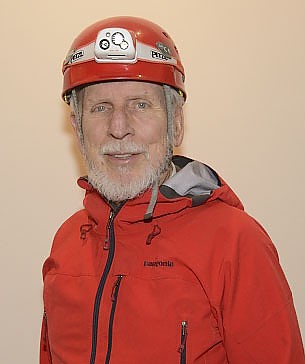
Battery life: To check the actual battery life against the specifications, I measured the energy density using my Sekonic calibrated light meter at intervals from full charge until the battery ran out. As the graph shows, there was a short initial half hour dropoff of about 600 lux until the power controller settled to a constant 2120 lux (9.9 EV) for 2 more hours. The level then dropped quickly to 450 lux (7.7 EV), staying steady at the “reserve” level for another half hour before shutting off. Petzl states that this “reserve” level is intended to provide time to complete your activities. This confirmed the specified battery life of 2h30min.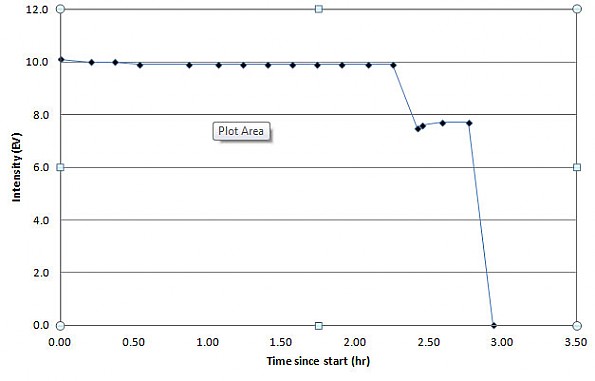
This highlights a problem with electric headlamps — battery life is short, and with high-brightness headlamps is very short when you run them at high settings. As noted, in Constant Lighting mode, use of the highest setting gives only about 2.5 hours, and similarly in Reactive Lighting mode. This is clearly inadequate for many predawn approaches to climbs, as well as returns to camp from an extended say of hiking or climbing.
Stepping down to the middle level in each mode, doubles the life to 5 hours, and to the lowest light level (which is adequate for most hiking, though not for complex navigation) gives 10 hours. The Reactive Lighting mode can extend the battery life further, if the terrain is light-colored (such as glaciers and snow fields.
You can carry a spare battery, though Petzl emphasizes use of only their proprietary Accu-Tikka R lithium rechargeable (about $27 for extras). I did notice on the Petzl website that a battery holder that takes 3 AAA cells will be available in another few weeks, but have not been given a sample or had a chance to test it to see what the battery life will be)
Lumens and lux: Petzl and some other companies specify brightness in lumens, while other companies give their specification in lux. If you are not familiar with light measurement, this can be confusing. To over simplify a bit, lumen is a measure of total light output, while lux is a measure of light “density”. The two are related in that 1 lux is 1 lumen per square meter. Since the intensity (or think of it as the energy density) falls off as the square of the distance, the light falling on a 1 meter square white test card at 10 meters is 4 times as bright as on the same 1 meter square card at 20 meters, measured in lux. If you use a 4 square meter white card at 20 meters, the total light will be the same as the 1 square meter test card at 10 meters (you have 4 times the gathering area, so the total lumens remain the same).
The total amount of light falling on an object is also dependent on the cone angle of the beam. In some older incandescent and halogen headlamps, the cone angle (often called “focus”, though there was no focusing involved) could be varied by screwing the reflector in and out. None of the current LED lamps are adjustable in that sense. The RXP has two lamps, one with a relatively narrow cone of light shaped by a fixed reflector, the other, lower power LED with a diffusion screen in front of the LED. The two lamps are used combined or singly, with variable light levels for each, as programmed with the stored profiles. The RXP’s wide beam is about 10 times larger in area (that is, the solid angle) than the spot beam. Note that this means that if the two LEDs were putting out the same total light (same number of lumens), the brightness illuminating any point in the wide beam would be 10% of that illuminating a point in the spot beam.
Visibility distance: Petzl and many other manufacturers state a visibility distance for the various light levels, in addition to or instead of a light intensity or total output level. Since this is normally determined according to the European standard, this is a reasonable way to get a relative comparison. The CE (European standards organization) specification uses the distance at which the brightness of a test card illuminated by the headlamp is that produced by the full moon (on a clear night, of course, not like our typical San Francisco area foggy nights).
The full moon provides a 0.25 lux illumination. My presbyopic eyes can read the second or third level headlines on the New York Times by the light of the full moon, but not the stories (yes, I actually tried this). Maybe you youngsters can read the fine print by the full moon, though. I do find the full moon to be adequate for hiking on most Sierra trails in the open or on glaciers and snow fields.
On the trail: I went to one of the few parks around here that allow night entry, as I did with the three previous lamps I tested for Trailspace. During the 6 mile hike with 2200 feet of accumulated elevation gain, I noted that the reflectorized signs intended to dissuade hikers from going off trail were visible from several hundred meters away. I also went out for a few walks around the block, noting that I could easily see our California reflectorized license plates and stop signs up to a block away. Our area has standardized 1/8 mile blocks, so I was spotting the reflectors up to 200 meters away.
Of course, this is not like seeing details that far away in the dark woods or on a mountain trail, since stop signs and reflectorized license plates are intended to be seen at long distances. During my long hikes (described later), I did find that I could spot animal eyes at long distances as well. Petzl specifies 100 meters as the visibility distance at their maximum 150 lumen setting (Constant lighting) and 110 meters at the maximum 215 lumens (Reactive lighting).
I also could spot reflections from the eyes of the cattle which are allowed to graze in the park at very large distances (keeps the vegetation trimmed to a low level and reduce the fire danger in our drought-stricken state). These cattle are black angus, which makes it interesting to get closer and closer to a pair of eyes, not knowing if it is a black cow (hence invisible at a distance in the dark) or one of the mountain lions who frequent the park. While we were in Colorado for the American Alpine Club annual meeting, I also had a chance to see the Reactive Lighting in action while walking a short distance in the snow, where it behaved as expected – dimming when directed at the snow and brightening when traversing bare ground.
Water resistance: The RXP is rated as IPX4 (protected against sprayed water), with a written caution against immersing the battery. In case it does get wet, Petzl says to open the case, remove the battery, and dry everything. For salt water, they recommend rinsing the battery and headlamp, then drying. Since many of the intended activities are likely to involve heavy rain or snow, as well as wet snow, not to mention the potential of accidentally dropping it in a stream or lake, I checked the waterproof qualities by immersing the lighted headlamp in a sink of water for several minutes. After thoroughly drying the battery and lamp, I reassembled it and turned it on. It appears to be working normally.
Night views: To get photos for this review, I wore the RXP on my head (no helmet) while hiking up and down the trail on Mission Peak. At the summit, I took a number of photos with my Nikon D800 by bracing the camera on handy boulder, standardized at 1 second, f/3.5, and ISO 1000 for easy comparison of different settings. This worked quite well, as can be seen in the summit shot below. I stood at the true summit and shined the RXP over at the observation pole that most people think is the summit (I stood on the true summit for this review, where for the other 3 lamps I stood a few feet lower and closer to the observation pole).
I measured the distance using my Leica Distal laser “tape” at 154 feet (47 meters). I photographed the lit area with the camera set at 1 second, f/3.5, ISO 1000. The night was partly cloudy, with a full moon. The lights of the San Francisco Bay provide a background, with San Francisco itself at the right (north) side of the photo in the distance, Fremont closer in, and San Jose to the left. The image is pretty much as the eye sees it. The Petzl specification of the lit distance is 100 meters. On the way up and down, there were places where it was obvious that objects up to 100 meters away were lit. 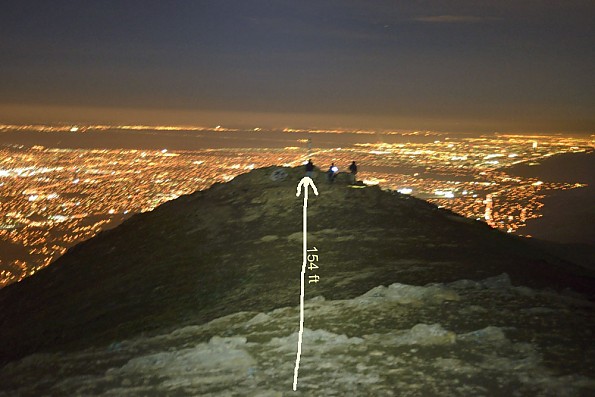
With the NAO and the Black Diamond Icon Polar on maximum output, I found that oncoming hikers would stop and turn their backs, cover their eyes, and otherwise just stop hiking until I was past. I even had one blinded hiker threaten to “rip that light off your head” with the NAO at full power. This was despite my aiming the headlamp downward or turning my head to the side. Based on this, I used the Constant wide beam for hiking on highly populated trails (with the side benefit of longer battery life), the Reactive “Max Autonomy” setting (lowest power) for most other trails with fewer hikers, and the “Max Power” for darker wooded areas. I had no complaints from other hikers with the Constant wide beam, as long as I turned my head to direct the beam away from them.
While I did not run an actual night orienteering event, I did do some off-trail walking in a local city park with a map in hand. The lamp color is sufficiently like daylight to render the colors on the map recognizable. The automatic brightness adjustment when looking from the landscape to the map and back worked very well. This has always been a problem with older lamps, since the brightness reflecting from the map is often enough to spoil your night vision.
The park has a marked-off soccer field, which made it easy to measure visibility distances. I had Barbara walk away from me on the field to see how far I could see her, and how far from the headlamp she could see detail on the ground (the field area of the park has no lighting, being used for soccer only during the daytime). I could still see her as a human figure at 110 meters, even being able to discern the blue color of her jacket. At 120 meters, she still could discern detail on the ground at her feet. Note that this was an open field. Your results in a densely wooded area will obviously be very different.
Conclusions: The RXP is an excellent choice for a wide variety of outdoor activities, providing a controllable way of matching appropriate light levels to the situation. It appears to be sufficiently rugged for heavy use in active activities like mountaineering, rock climbing, and orienteering, as well as those times when you have to spend time in a bivouac or holed up in a tent of snow cave waiting out a storm. The rather stiff price ($90) is typical of the most recent high-powered headlamps, but the performance and versatility seems well worth it.
I have some minor quibbles that led me to give the RXP a minor reduction to 4.5 stars out of 5. The big quibble is that battery life is short for a headlamp that will be used on long approaches and exits in the mountains or on longer orienteering competitions where the brightest settings are of particular advantage. Some means of recharging the battery or extra battery packs would be necessary on long expeditions or backpacking trips. Petzl’s website indicates that a battery case to hold 3 AAA cells will be available, providing 70% of the capacity of the supplied rechargeable lithium battery. A second quibble is that the battery life of the supplied rechargeable lithium-ion battery is limited to about 300 recharging cycles (Petzl says that at 300 cycles, battery capacity is about 70%).
Some of the climbs I have done and intend on doing require more hours than are available of daylight. Some, over glaciers or snow and ice, are best done in the early morning hours, which can mean leaving camp or the bivy site at midnight or even earlier. Thus I require sometimes 5 hours or more of dependable lighting. Years ago, this meant carrying a large number of spare batteries. Also, the approaches were (and are) often at low temperatures. Lithium batteries (both lithium-ion and rechargeable) have helped tremendously with their longer life and cold resistance. But they do not solve everything. On a long expedition or hiking one of the long trails (AT, PCT, or even just the JMT), the supply of batteries would be excessive.
As mentioned above, Petzl’s battery is charged via a USB connection (5 hours for a full charge). This does leave the possibility of carrying a solar panel or one of the thermoelectric chargers. Having one or two spares and recharging during daylight hours might prove a (costly) solution. The pending availability of a battery holder might also be a solution.
Finally, did the RXP meet the 8 criteria I gave at the start? My personal answer is “yes” to the all eight. Whether you, the reader can answer the eighth question in the affirmative depends on your activity and level of involvement with the activity. In short, I would recommend that any climber, orienteer, backpacker, or others engaged in outdoor activities involving night-time activity (or spelunkers) give serious consideration to the RXP.
Source: received for testing via the Trailspace Review Corps
(Sample provided by Petzl for testing and review)
DO NOT PURCHASE THIS HEADLAMP.
Constant software and charging issues. Customer Service at Petzl constantly offers technical solutions that provide no fixes. NEVER works when you need it to work. Highly recommend NOT purchasing this or any other Petzl product offerings.
Pros
- Great design
- Fits perfectly
- Easily adjustable
Cons
- NEVER works when you need it to.
- Customer service is non-existent
- Constant charging / software issues.
- DO NOT PURCHASE THIS PRODUCT
Would never recommend purchasing a Petzl product. Worst experience I've ever had with any device or Customer Service Department.
Background
Worst headlamp I've EVER owned.
Source: bought it new
Price Paid: $100 +
Your Review
You May Like
Specs
| Price |
Historic Range: $59.97-$99.95 |


